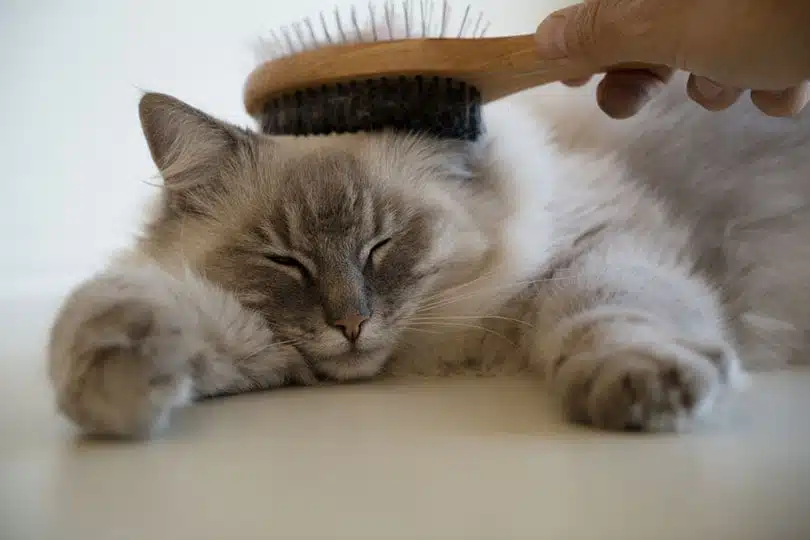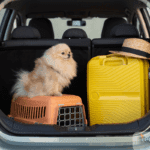Expert Grooming Tips
Ragdoll cats are renownedadored for their striking blue eyes, semi-long silky luxurious semi-long fur, and affectionate demeanor. However, their luxurious coat and unique needs mean grooming is essential not only for their appearance but also for their overall health. This guide will walk you through everything you need to know about grooming your Ragdoll catnature. Grooming is not just about maintaining their beauty—it’s essential for their health and happiness. Let’s dive into this ultimate guide to help you care for your Ragdoll like a pro.
Why Your Ragdoll’s Coat Needs Special Care
Think of your Ragdoll’s coat like a “luxurious velvet blanket” – soft, elegant, and requiring careful maintenance! Their semi-long fur is unique and needs special attention because:
- It has a silky texture that tangles easily without regular care.
- Their seasonal shedding can lead to increased hairballs if not managed.
- Grooming keeps their coat shiny and their skin healthy.
During grooming, take the opportunity to check for any signs of skin redness, bumps, or bald patches. These could indicate dermatitis, parasites, or fungal infections that may need veterinary attention.
Dr. Esther Knoetze, BVSc, shares: “A Ragdoll’s coat, while less prone to matting than some other breeds, can develop tangles if neglected for even a few days. Regular grooming isn’t just aesthetic; it’s a crucial part of their health care routine.”
- • Gently part your cat’s fur
- • You should be able to see their skin
- • If you can’t, you need to brush more thoroughly
💡 Extra Tip:
When caring for such a gentle breed, make sure your grooming area is stress-free. Need ideas? Check out our Cat-Proofing Your Home Guide.
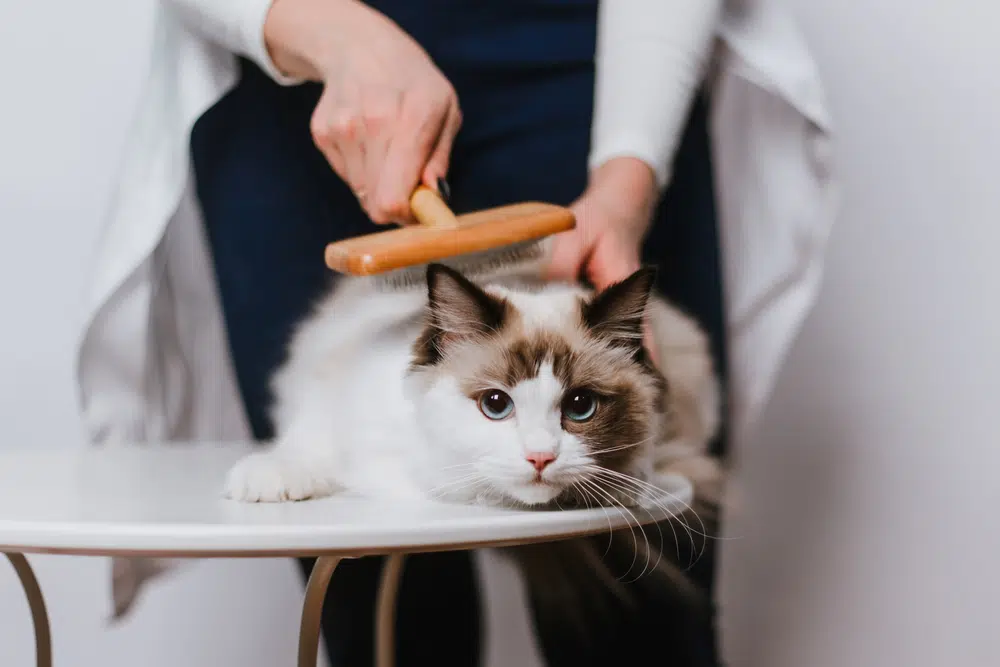
Your Essential Ragdoll Cat Grooming Kit
Wide-toothed Metal Comb
- Why you need it: Essential for reaching deep into the dense undercoat to prevent mats and tangles.
- Look for: Stainless steel with 4-6 mm tooth spacing for effective grooming without pulling.
- Pro Tip: Stainless steel combs reduce static and glide smoothly through fur.
A good comb helps detect fleas or ticks. Look for flea dirt (small black specs) at the base of the fur while combing.” – Dr. Esther Knoetze, BVSc.

Stainless Steel Pet Grooming Comb Set – Wide, Dense & Flea Tooth Combs (3 pack)
Made with premium stainless steel, round and gentle teeth for scratch proof, very durable and smooth. Effectively remove loose hair, dander & dirt trapped beneath fur.
Slicker Brush
- Why you need it: Removes loose fur and prevents shedding.
- Look for: Flexible bristles with rounded tips.
- Pro Tip: “Always brush in the direction of hair growth,” advises Dr. Esther Knoetze.
💡 Money-Saving Tip: Start with a wide-toothed comb and slicker brush—these tools cover about 80% of your grooming needs.

Hertzko Self-Cleaning Dog & Cat Slicker Brush
This brush gently removes loose hair and eliminates tangles, knots, dander, and trapped dirt. It features a comfortable grip and a self-cleaning function for easy maintenance.

Hepper Deshedding Cat Brush
ONE PUSH RELEASE – This kitten brush / cat brush pops out fur with just a simple press, leaving you…
DURABLE – Cat shedding can be a tough ordeal. Made of resilient ABS plastic and metal bristles with…
COMFORTABLE – A cat fur brush with 60 degree angled, fine bristles and rubber stoppers will bring…
Cat-Safe Shampoo
- Must be: pH balanced (6.5-7.5).
- Look for: Hypoallergenic formula free from artificial fragrances and harsh chemicals.
- Avoid: Human shampoos—they disrupt your cat’s skin pH balance.
“Over-bathing can strip your Ragdoll’s skin of natural oils, leading to dryness. Consult your veterinarian to determine the ideal bathing frequency.” Dr. Esther Knoetze, BSc, BVSc.
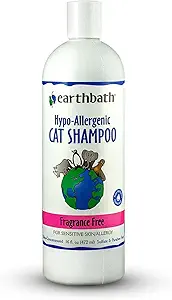
Hypoallergenic Cat Shampoo – Fragrance Free Cat Shampoo for Allergies and Itching, Made in USA
This fragrance-free, pH-balanced shampoo is designed for sensitive skin, ensuring a gentle and effective clean without irritating your cat’s skin.
Microfiber Towels (at least 2)
- Why: Quick-drying and gentle on the coat.
- Pro Tip: “Pat, don’t rub, to prevent tangles,” shares Maria.
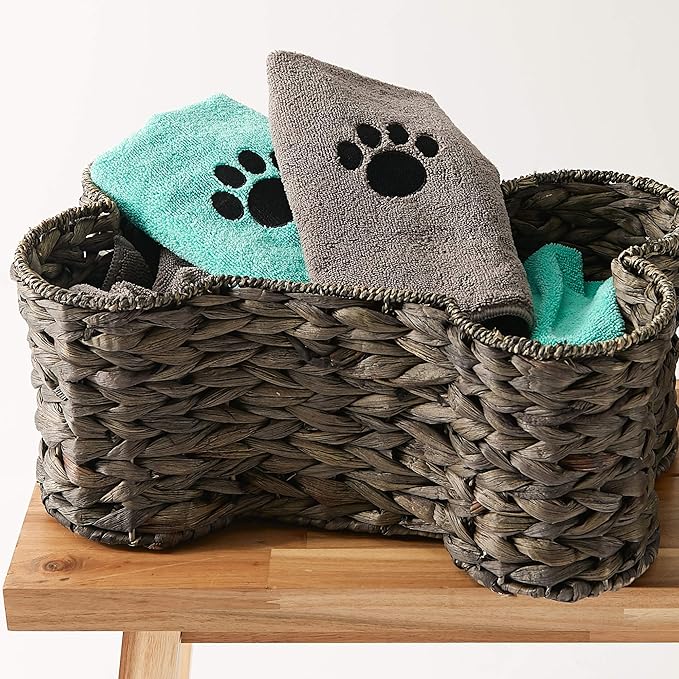
Bone Dry Pet Grooming Towel Collection Embroidered Absorbent Microfiber Drying Set, 15×30,
These absorbent microfiber towels are perfect for drying your cat efficiently while being gentle on their coat.

Tackling Common Grooming Challenges
1. Start Early
Ragdolls are known for their calm and affectionate nature, making them ideal for new cat owners. However, like any cat, they can be wary of unfamiliar tools and routines. Starting grooming sessions early helps them adjust faster, building trust and making grooming an enjoyable bonding activity.
- Kittens Adapt Quickly: Young Ragdolls are naturally more adaptable. Introduce grooming tools gently and use treats to create positive associations.
- Older Cats Need Time: For adult Ragdolls, patience is key. Familiarize them with brushes before starting grooming sessions to reduce anxiety.
“Starting grooming early not only ensures a well-maintained coat but also helps in identifying early signs of skin issues or parasites.” – Dr. Esther Knoetze, (BSc) (BVSc).
New cat owner? Our Vet-Approved New Cat Supply Checklist will jump start you with trusted products.
2. Develop a Routine
Consistency is essential for maintaining your Ragdoll’s beautiful coat. Tailor the grooming schedule to their coat condition, the season, and their individual grooming needs.
- Seasonal Grooming: During spring, when cats shed their winter coats, brushing helps minimize loose hair and keeps your home fur-free.
- Adjust for Age: Older Ragdolls, especially those with arthritis or reduced mobility, may need additional help with self-grooming.
💡 Pro Tip: “Daily brushing during shedding seasons and twice-weekly grooming at other times keeps your Ragdoll’s coat manageable and healthy.”
3. Keep Sessions Fun
Grooming should be a positive experience for both you and your cat. By keeping sessions enjoyable, your Ragdoll will associate grooming with quality bonding time.
- Shorter Sessions: If your cat becomes restless, split grooming into shorter, manageable sessions with breaks for treats.
- Stay Calm: Use a soothing voice, gentle strokes, and positive reinforcement to make grooming sessions stress-free.
💡 Extra Tip: Use a non-slip mat on your grooming table and keep your Ragdoll’s favorite toy nearby for added comfort.
4. Focus on Problem Areas First
Begin grooming with areas that require the most attention, like the stomach and legs, before moving to less challenging spots like the back.
- Why Start Here? Tackling difficult areas first ensures you address them before your cat loses patience.
- Stress Reduction: Work in small sections, finishing with areas your cat enjoys, like the chin or back.
💡 Pro Tip: “Use a detangling spray for stubborn knots and always monitor for irritation.”
5. Use a Variety of Brushes
The right tools are crucial for effective grooming. A well-equipped grooming kit helps manage Ragdoll fur efficiently.
- Soft Bristle Brushes: Ideal for kittens or sensitive areas, distributing natural oils and easing your cat into the routine.
- Rubber Brushes: Great for removing loose undercoat hair while being gentle on the skin.
- Pin Brushes & Combs: Effective for detangling but should be introduced gradually to avoid discomfort.
💡 Pro Tip: “Start with softer brushes and work up to tools designed for tough mats and tangles.”
6. Can You Shave a Ragdoll Cat?
Is it a good idea to give your Ragdoll cat a haircut? While it’s possible, it’s not typically necessary. Ragdolls have a luxurious, semi-longhaired coat that is naturally low-maintenance and not prone to matting when brushed regularly. However, there are circumstances where trimming or shaving might be considered.
When Shaving Might Be Necessary:
- Severe Matting: If your Ragdoll’s fur becomes heavily tangled or matted, causing discomfort or pulling on their skin, shaving may be the safest option.
- Hygiene Issues: Dirt, debris, or sticky substances embedded in the coat might necessitate localized trimming or shaving.
- Medical Reasons: A veterinarian may recommend shaving for certain skin conditions or surgical procedures.
Alternatives to Shaving:
Before reaching for clippers, try these steps to address problem areas:
- Apply a small amount of coconut oil to the matted fur.
- Let the oil sit for about an hour to loosen the tangles.
- Use a de-matting comb to gently work through the knots.
- For stubborn mats, carefully trim with blunt-ended scissors or a nail clipper.
What to Keep in Mind if Shaving Is Necessary:
- Indoor Cats Are Safer: Unlike outdoor breeds, Ragdolls are typically indoor cats, making them less vulnerable to temperature extremes or sunburn after shaving.
- Leave It to Professionals: If shaving becomes unavoidable, consider seeking the help of a professional groomer to ensure the process is stress-free and safe for your cat.
“Matted fur can cause significant discomfort and even lead to skin infections. If mats persist or spread, consult your vet or a certified groomer for the best course of action.” – Dr. Esther Knoetze, (BSc) (BVSc).
7. Battling the Dreaded Mats
Mat Danger Zones:
- Behind ears (high friction & heat).
- Under collars (prone to skin irritation).
- Armpits (moisture-prone areas).
- Groin area (sensitive skin).
- Base of tail (oil accumulation).
Dealing with Mats Safely:
- Small Tangles:
- Use a detangling spray and wait 2-3 minutes.
- Gently separate with fingers and comb through carefully.
- Stubborn Mats:
- Use a mat splitter, working from the edges inward.
- Take frequent breaks and avoid pulling to prevent skin trauma.
⛔ Medical Alert: Never use scissors near the skin or force a comb through a mat. Always seek professional help if mats are severe.
8. Managing Shedding Season
“Ragdolls shed year-round, but spring and fall are peak shedding seasons. Excessive shedding may signal health issues.” – Dr. Esther Knoetze, (BSc) (BVSc).
Prevention Strategies:
- Brush daily during peak shedding seasons.
- Incorporate omega fatty acids into their diet for a healthier coat.
- Schedule regular baths every 4-6 weeks.
- Monitor for bald patches or irritated skin.
Clean-Up Solutions:
- Keep lint rollers handy for quick furniture clean-ups.
- Invest in a high-quality vacuum to handle pet hair.
- Use washable furniture covers to simplify cleaning.
- Track shedding patterns to identify any irregularities.
🏥 When to Consult a Vet:
- Sudden increases in shedding.
- Visible bald spots.
- Persistent skin irritation or excessive scratching.
9. Use Positive Reinforcement
Ragdolls love to laze about, but they’ll still appreciate a treat after grooming. Rewarding them for sitting still or tolerating brushes builds trust and makes future sessions easier.
💡 Pro Tip: “Treats and praise after a tough session help associate grooming with positive outcomes.”
10. Listen to Your Cat
Even the laid-back Ragdoll has limits. Pay attention to their body language to ensure grooming is comfortable and enjoyable.
- Recognize Discomfort: Overgroomed or irritated skin can make brushing painful. Switch to gentler tools if necessary.
- Tackle Stubborn Mats with Care: If fur pulling causes discomfort, reassess your technique to avoid stress.
💡 Extra Insight: “Listening to your cat ensures grooming is a bonding moment, not a battle.”
11. Dealing with Tear Stains
🔬 The Science Bit: Tear stains form when molecules in tears (porphyrins) oxidize upon exposure to air. While not common in Ragdolls, they can occur due to individual variations.
Morning Care:
- Wipe gently with warm water and a clean cloth.
- Use a fresh section of cloth for each eye.
- Check for changes in discharge color or consistency.
Evening Care:
- Use pet-safe eye wipes to clean the area.
- Apply enzymatic cleaner if needed.
- Monitor for swelling or irritation.
- Track tear production changes.
A high-quality diet free of artificial dyes and rich in omega-3s supports overall skin health, reducing the likelihood of tear staining.” – Dr. Esther Knoetze, (BSc) (BVSc).

Professional Grooming & Health Checks
Signs It’s Time for Expert Help
- Severe matting.
- Persistent skin issues.
- Strong odors.
- Stressed cat or owner.
- Unexplained coat changes.
If you notice persistent dandruff, thinning fur, or scabs, schedule a veterinary check-up to rule out underlying issues like allergies or fungal infections before proceeding with grooming.” – Dr. Esther Knoetze, (BSc) (BVSc).
Professional Service Expectations
⏱️ First visit: 2-3 hours (includes health assessment).
⏰ Regular visits: 1-2 hours.
💰 Cost: $50-$100 (varies by location).
📅 Frequency: Every 8-12 weeks for maintenance.
Must-Have Qualifications for Groomers
- Certified Feline Master Groomer (CFMG).
- Experience with Ragdoll cats.
- Clean, quiet facility.
- Current pet first aid certification.
- Relationship with a local vet clinic.
Seasonal Grooming Adaptations
Summer Care (20-30°C / 68-86°F) ☀️
- Increase brushing frequency.
- Watch for overheating during grooming.
- Consider a “summer cut” if needed.
- Use cooling mats during sessions.
Winter Care (15-20°C / 59-68°F) ❄️
- Monitor for dry skin.
- Use pet-safe moisturizing sprays.
- Keep indoor humidity balanced.
- Reduce bathing frequency.
A humidifier can help combat dry air during winter, keeping your cat’s skin hydrated and comfortable. This reduces the risk of skin issues and static electricity in their coat.” Dr. Esther Knoetze, BSc, BVSc.
Emergency Grooming Situations: Quick Action Guide
Emergency Kit Essentials 🧰
- Vet and groomer emergency numbers.
- Pet-safe scissors (blunt-tipped).
- First aid supplies.
- Styptic powder.
- Cat carrier.
- Calming aids prescribed by your vet.
📌 Read More: “If you notice skin irritation or unexpected injuries, consult our Veterinarian’s Complete Cat Emergency Guide for critical care tips.”
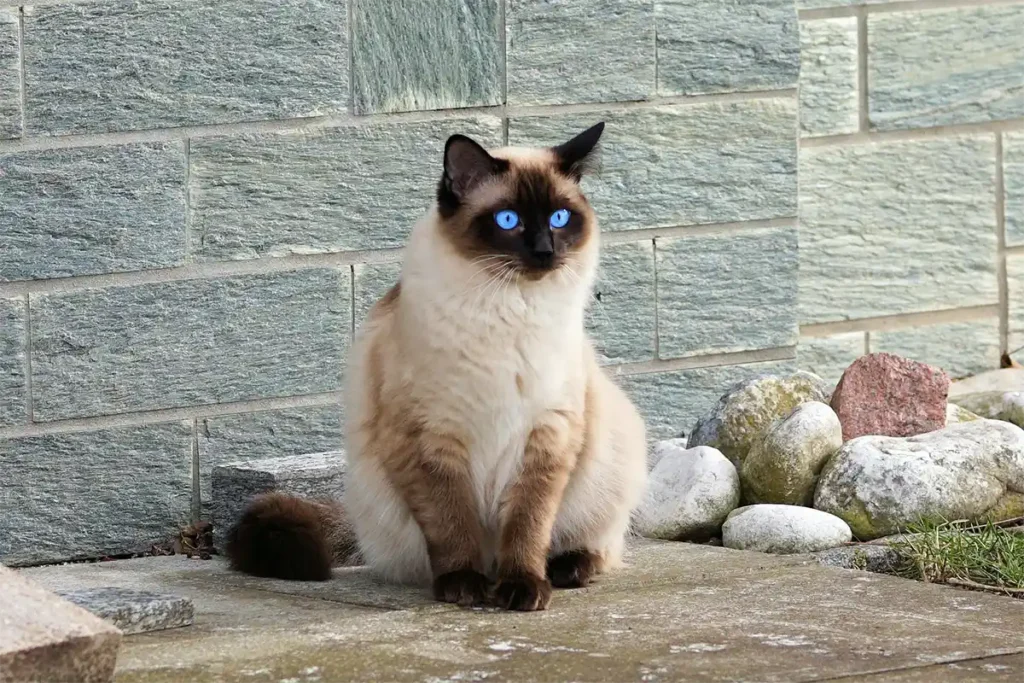
Brushing Techniques for Your Ragdoll Cat
Brushing your Ragdoll is more than just coat maintenance—it’s a moment to strengthen your bond while ensuring your cat’s health and comfort. Follow these expert-tailored tips to turn grooming into a stress-free and enjoyable experience:
Brush in the Direction of Hair Growth
Think of brushing as an extension of gentle petting. Start at the head and glide down the back, sides, chest, and legs. Brushing against the grain can tug on fur, causing discomfort and even tangles.
Start with a Wide-Toothed Comb or Undercoat Rake
Begin with sweeping strokes using a wide-toothed comb to remove loose fur and untangle the undercoat. This step prevents mats from forming and keeps the coat smooth.
Follow Up with a Slicker Brush
After working through the undercoat, switch to a slicker brush to polish the topcoat. Use light, controlled strokes to remove surface debris and loose hair, leaving your Ragdoll’s coat glossy and healthy.
Handle Sensitive Areas with Extra Care
Sensitive spots like the belly, behind the ears, and near the tail require a soft touch. Opt for a gentler brush or grooming glove to avoid discomfort.
Focus on Matting Hotspots
Ragdolls are prone to mats in high-friction areas like the chest, armpits, and under the legs. Use your comb to gently work through tangles, applying a detangling spray if necessary to avoid stress.
Brushing Tips for Nervous Ragdolls
If your Ragdoll seems apprehensive about grooming, these tips can help create a more positive experience:
- Start Slow: Begin with short grooming sessions lasting just a few minutes and gradually increase the time as your cat adjusts.
- Reward Positive Behavior: Offer treats and soothing praise throughout and after the session to encourage cooperation.
- After Playtime: Brush your Ragdoll after a fun play session when they’re relaxed and more receptive.
- Choose a Quiet Grooming Space: Select a calm, distraction-free area where your cat feels secure.
By incorporating these strategies, brushing becomes a bonding ritual that enhances your Ragdoll’s coat while deepening your connection.
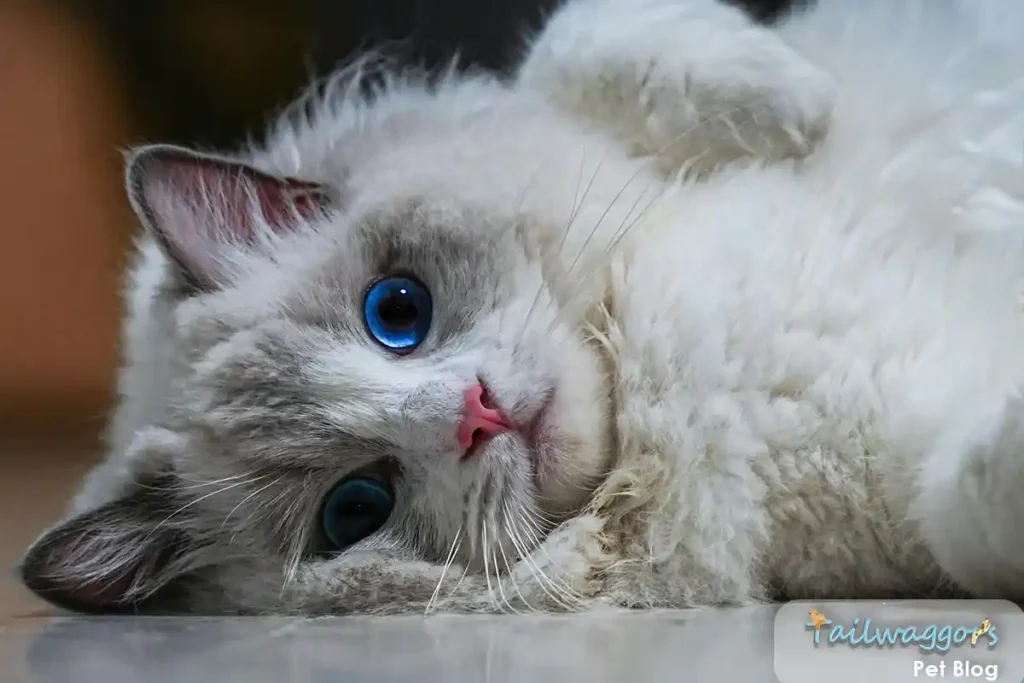
Bathing Your Ragdoll
While Ragdolls are natural self-groomers, occasional baths can be beneficial for maintaining hygiene and coat health. Treat bath time as a luxurious spa experience for your feline friend, reserved for special circumstances like messy adventures or an oily coat.
When to Bathe Your Ragdoll
- After a Messy Mishap: If your Ragdoll has rolled in something sticky or dirty, a bath is the best way to restore their elegant appearance.
- Greasy Coat: An overly oily coat may require a gentle cleanse to remove buildup and maintain its natural sheen.
Bathing Basics
Turn bath time into a stress-free event with these essential tips:
- Use Lukewarm Water: Ensure the water is tepid to keep your Ragdoll comfortable and prevent skin dryness.
- Choose a Cat-Specific Shampoo: Always opt for a gentle, pH-balanced shampoo and conditioner formulated for cats to protect their coat and skin.
- Massage, Don’t Scrub: Apply shampoo with a soft massaging motion, avoiding the face and ears. Rinse thoroughly to remove all product residue.
- Optional Conditioning: A cat-safe conditioner can make detangling easier and add a healthy, silky finish to their coat.
Drying Your Ragdoll After a Bath
Towel Dry First
Wrap your Ragdoll in a soft microfiber towel to absorb as much moisture as possible. Gently pat instead of rubbing, as this can cause tangles or discomfort.
Optional Blow-Drying
If your cat tolerates it, use a blow dryer on the lowest heat and speed settings.
- Maintain Distance: Keep the dryer at a safe distance to prevent overheating.
- Monitor Your Cat’s Comfort: If your Ragdoll shows signs of anxiety, return to towel drying immediately.
Modern Drying Solutions
Consider using a cat blow-drying tent that provides gentle airflow. Ensure your Ragdoll can exit freely to avoid stress while speeding up the drying process.
By mastering these brushing and bathing techniques, you’ll not only keep your Ragdoll’s coat healthy and tangle-free but also create meaningful moments of connection. Grooming isn’t just a necessity—it’s a cherished ritual that strengthens your bond with your beloved feline companion.
Ragdoll Grooming FAQs
How often should I groom my Ragdoll cat?
+Ragdolls have luxurious semi-longhaired coats that require regular care to keep them looking their best.
- Recommendation: Brush your Ragdoll at least twice a week to prevent tangles and reduce shedding.
- Shedding Season: Increase grooming to daily sessions during spring and fall to manage seasonal shedding and minimize hairballs.
🩺 Expert Tip:
“Regular grooming keeps your Ragdoll’s coat healthy and strengthens your bond.” – Dr. Esther Knoetze, BVSc
What tools are best for grooming a Ragdoll cat?
+A Ragdoll’s grooming kit should include:
- Wide-toothed comb: Reaches the undercoat and detangles effectively.
- Soft-bristle brush: Ideal for distributing natural oils.
- Slicker brush: Removes loose fur and prevents mats.
- Grooming gloves: Perfect for gentle grooming and sensitive areas.
📚 Reading Tip:
Check out our Ultimate Guide to Cat Grooming Tools for more detailed information.
Can I bathe my Ragdoll cat?
+Bathing is rarely necessary for Ragdolls, as they are excellent self-groomers. However, occasional baths can help if they get dirty or have a skin condition.
- How to Bathe: Use a pH-balanced, hypoallergenic cat shampoo and lukewarm water.
- Aftercare: Dry thoroughly with a microfiber towel to avoid chills.
🐾 Pro Tip:
Overbathing can strip natural oils from their coat. Consult your vet to determine the right bathing frequency.
How can I prevent my Ragdoll’s fur from matting?
+Regular brushing is the best way to prevent mats.
Focus Areas: Behind the ears, under the legs, and around the collar where tangles form easily.
Dealing with Mats: Gently work them out using a detangling spray and comb. For severe mats, seek professional grooming assistance.
🩺 Veterinary Insight:
“Matted fur can lead to skin infections if not addressed promptly.” – Dr. Esther Knoetze, BVSc
Do Ragdoll cats shed a lot?
+Yes, Ragdolls shed year-round, with peak shedding during spring and fall.
- Management: Regular brushing and a diet rich in omega fatty acids can help minimize shedding.
- Proactive Care: Use lint rollers and washable furniture covers to keep your home fur-free.
Should I trim my Ragdoll cat’s nails?
+Yes, regular nail trims are important to prevent overgrowth and injuries.
- Frequency: Trim every 10-14 days.
- How To: Use cat-specific nail clippers and take care not to cut the quick.
🐾 Pro Tip:
If you’re unsure how to trim your cat’s nails, consult a veterinarian or professional groomer for guidance.
How can I make grooming a positive experience for my Ragdoll?
+To ensure your Ragdoll enjoys grooming sessions:
- Start Early: Introduce grooming tools during kittenhood to build familiarity.
- Positive Reinforcement: Use treats and praise during and after sessions.
- Short Sessions: Keep grooming sessions brief, gradually extending as your cat gets comfortable.
- Create a Calm Environment: Groom in a quiet, stress-free space.
🩺 Expert Insight:
“Grooming can become a bonding experience your Ragdoll looks forward to.” – Dr. Esther Knoetze, BVSc
When should I seek professional grooming services for my Ragdoll?
+Professional grooming is recommended if:
- Your Ragdoll has severe matting that cannot be safely removed.
- They exhibit signs of skin irritation or infection.
- You are uncomfortable trimming their nails or bathing them.
🩺 Veterinary Insight:
“Certified groomers have the tools and expertise to handle complex grooming needs.” – Dr. Esther Knoetze, BVSc
How can I care for my Ragdoll’s teeth and ears?
+- Teeth: Brush regularly with a cat-specific toothbrush and toothpaste to prevent dental issues.
- Ears: Check weekly for dirt or signs of infection and clean gently with a vet-recommended ear cleaner.
🐾 Pro Tip:
Maintaining oral and ear hygiene is essential for your Ragdoll’s overall health.
Is it necessary to trim my Ragdoll’s fur?
+Routine haircuts are not needed for Ragdolls, but occasional trims may be necessary in specific cases:
- When Needed: Severe matting, hygiene issues, or medical reasons.
- Professional Help: Consult a professional groomer to ensure safety.
🐾 Extra Insight:
Their silky coat is low-maintenance with regular brushing, making trims unnecessary for most Ragdolls.
Final Words of Encouragement
Proper grooming is more than just aesthetics – it’s a crucial part of your Ragdoll’s health care routine. Your dedication to learning proper grooming shows how much you love your cat. Take it one day at a time, celebrate small victories, and know that our community, including veterinary experts, is here to support you.
⭐ Your Next Steps:
- Go through our beginner’s checklist
- Start with just 5 minutes daily
- Share your journey with us! Contact Tailwaggors
🐾 Obsessed with Ragdoll Cats? Us too! 🐱
Share this guide with your fellow Ragdoll cat enthusiasts and help them uncover the secrets to keeping their feline friends looking fabulous and feeling great! 🧴✨
📩 Spread the purr-fect care tips today!


